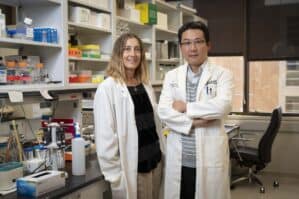By David Robinson

April 4, 2024 | LITTLE ROCK — Researchers at the University of Arkansas for Medical Sciences (UAMS) will use a $2.27 million grant from the National Institutes of Health (NIH) to answer key questions about the cellular mechanisms used by estrogen to prevent bone loss and osteoporosis.
The five-year NIH National Institute of Arthritis and Musculoskeletal and Skin Diseases (NIAMS) R01 grant is led by co-principal investigators Maria Schuller Almeida, Ph.D., and Ha-Neui (Hans) Kim, Ph.D. Almeida is a professor in the College of Medicine Department of Internal Medicine, Division of Endocrinology and Metabolism, as well as the Department of Orthopaedic Surgery. Kim is an assistant professor in the Department of Internal Medicine, Division of Endocrinology and Metabolism.
Aging and estrogen deficiency are major causes of osteoporosis and lead to a higher risk for bone fractures particularly in women.
“The significance of the problem is enormous,” Kim said. “With the increase in longevity, the number of people at risk increases dramatically.”
“Our skeleton is continuously remodeled by specialized cells that resorb old bone called osteoclasts and cells that produce new bone called osteoblasts. Sex steroid hormones, in particular estrogen, are good for our bones because they prevent excessive resorption by the osteoclasts. It is really important to understand how estrogen affects these cells,” Almeida said.
The study will test the team’s hypothesis of estrogen’s inhibitory effects on the mitochondria of osteoclasts. Their success could prove useful for the development of therapies that can treat osteoporosis.
Kim and Almeida aim to show that estrogen reduces the number and activity of osteoclasts by inhibiting some of the functions of a protein known as RANKL, which is indispensable for the formation of osteoclasts. Estrogen reduces RANKL stimulation of mitochondria, which provide the abundant energy required to break down bone tissue. The team will also test that the inhibition of RANKL decreases nicotinamide adenine dinucleotide (NAD+) and promotes mitochondria death. NAD+ is a coenzyme in all cells that is responsible for many metabolic processes including cellular energy production.
The team’s work builds on decades of research on the role of sex steroids on bone by Stavros Manolagas, Ph.D., and Robert Jilka, Ph.D., at the UAMS Center for Osteoporosis and Metabolic Bone Diseases, which was established nearly 30 years ago.
Research of a mineralized tissue such as bone presents unique challenges that require the sophisticated equipment found in the research cores supported by the UAMS Center for Musculoskeletal Disease Research (CMDR). The center is funded by an $11.5 million Centers of Biomedical Research Excellence (COBRE) Phase 2 grant from the National Institute of General Medical Sciences (NIGMS) branch of the NIH.
“Many cell types contribute to the health of our bones,” Almeida said. “However, these cells are difficult to isolate and study in a culture plate. Now with the advent of some recently developed techniques available at the UAMS Genomics Core, we are hoping to find answers that have been elusive to us.”
“If we can understand how estrogen affects bone cells, eventually we can then think about drugs that could mimic what estrogen does,” she said.
